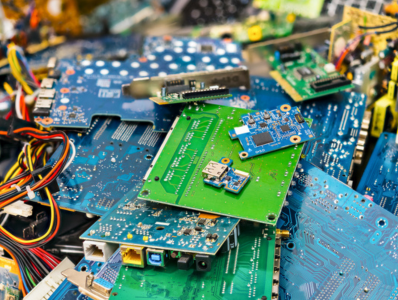Did you know that globally last year, the total amount of electronic waste reached 53.6 million metric tonnes? With such rapid advances in technology and endless new innovative products released every year, electronic waste will quickly become one of the fastest growing waste streams in the world.
Less waste can be produced through circular approaches to product design, business models, and procurement. Circularity can be built into products right at the design phase, ensuring they can be repaired, re-used, recycled or returned – keeping them out of landfill, and keeping our resources in the environment.
Facts and Stats
- Electronic waste (e-waste) includes unwanted electronic equipment, such as smart devices and used cables, as well as batteries and fluorescent lights (including compact fluorescent lights). The parts that make up your electronics, such as steel, glass, copper, aluminum, plastics and precious metals, can be recovered and made into new products.
- Consider donating or selling your electronic item instead of disposing them in your garbage. If users continue to landfill their products after the first use, or simply store them in a closet in perpetuity, the impact of better design is limited. Therefore, adopting new business models and deploying effective reverse cycles is instrumental to realising greater product circularity.
- Holding onto your device longer helps cut down on e-waste.
- The best way to reduce the impact that we have on the environment is to make sure that we can use the gadgets that we already have in our pockets for as long as possible.
- E-waste is hazardous material. Over time, electronics can leak toxic elements, like mercury and lead, which can be harmful to the environment and to humans. Donating your electronics for reuse or recycling them at safely managed sites helps control the hazards. Recycling also allows reliable resources found in electronics — recyclable plastics and even gold — to be reclaimed.
- On average, consumers keep cell phones for only two years before they trade them in or throw them out.
- A recent study from Tsinghua University in Beijing and Sydney’s Macquarie University found it was 13 times cheaper to mine electronic waste than it was to source new minerals by extracting it from the environment.
- According to the Brussels-based Bureau of International Recycling, Canada generated 638,300 tonnes of “e-scrap” — electronic and electrical equipment — in 2017. That amount is expected to climb. By 2025, the BIR estimates that Canada and the U.S. will cumulatively generate 9.25 million metric tons of e-scrap in that year alone.
- One ton of discarded mobile phones or PCs can contain up to 280 grams of gold, as well as high levels of base metals.
- The Global E-waste Monitor 2020 report found that the world dumped a record 53.6 million tonnes of e-waste last year — equivalent to the the weight of 350 cruise ships the size of the Queen Mary 2, or enough to form a line 125 kilometres long. That’s an increase of 21 per cent in five years, the report said. Just 17.4 per cent of it was recycled, meaning that an estimated $57 billion worth of gold, silver, copper, platinum and other high-value, recoverable materials used as components were mostly dumped or burned rather than being collected for treatment and reuse.
- It takes roughly 240 kg (530 pounds) of fossil fuels; 22 kg (48 pounds) of chemicals and 5 tons of water to manufacture a brand new computer.
- It is illegal in Canada to export e-waste to developing nations.
Organize a collection event
A majority of households have old electronics kicking around. As Canadian municipalities do not offer curbside e-waste collection, many residents rely on collection events for proper management of these materials. That’s why on Wednesday of Waste Reduction Week (or throughout the Circular Economy Month!) we encourage organizations, schools, and municipalities to host an e-waste collection event for reuse and/or responsible recycling.
